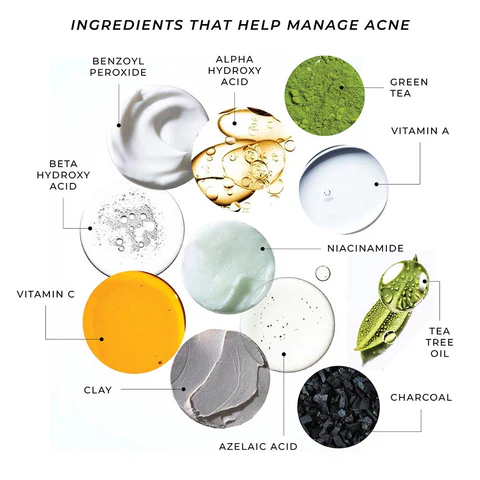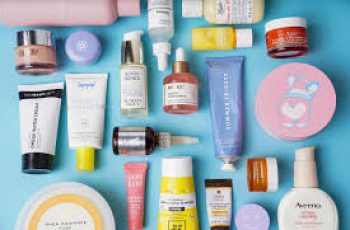
Which ingredients help fight acne?
Ingredients that help fight acne can work in a variety of ways to keep your skin blemish-free. There are many products on the market that fight various forms of acne – from cleansers, gels, foams, leave-ons, masks to serums – the list goes on, but which one is the best? What ingredients need to be considered? Let’s learn more about this.
The best ingredients for acne-prone skin?
There are many ways to treat and prevent acne using over-the-counter products. Some kill blemish-causing bacteria by unclogging pores, while others remove excess oil from the skin and support skin cell turnover by speeding up the removal of dead skin cell layers. Whichever product you choose, it’s the active ingredients that bring the results, and we’ll explore their benefits in more detail.
Salicylic acid. Salicylic acid is a beta-hydroxy acid (BHA) that penetrates the lower layers of the skin to remove dirt, bacteria, and excess sebum from pores, which can cause inflammation such as spots or blackheads if left behind. Salicylic acid is found in skin care products like cleansers, serums, oils, and moisturizers, all of which must contain active salicylic acid to achieve the desired blemish-removing effects. You can check the effectiveness of a product’s ingredients by carefully looking at the ink list on the packaging. If the acid is sixth on the list, the percentage is too low to have an effect on the skin or acne – high. Benzoyl peroxide. This ingredient helps kill any bacteria that cause acne and other skin blemishes, removes excess oil that can clog pores, and removes dead skin cells that can form spots and blemishes. Benzoyl peroxide is available in over-the-counter products in concentrations of 2.5% to 10% and is most effective when used regularly. Some side effects to watch out for include redness, flaking, itching, and dry spots. Alpha-hydroxy acids. These acids, also known as AHAs, are part of a large family of chemical exfoliants and are commonly found in products like cleansers, toners, serums, and moisturizers.
They work on the outer layer of the skin to loosen up dead skin cells by breaking the bonds between them, making it easier for bright, vibrant new skin cells to emerge. If you want to fight acne, the best AHAs for your skin are
Glycolic acid and lactic acid. Both are suitable for all skin types and are not overly drying when cleansing.
As detailed on the NHS website, there are also prescription treatments and medication options for treating severe cases of acne, including the following: Topical tretinoin. Topical antibiotics. Azelaic acid. Antibiotic tablets. Combined oral contraceptive pills for women. If you are concerned about your acne or wondering how to treat it, talk to your primary care doctor or dermatologist to get a clearer idea of the next steps in treating it.
Best natural ingredients for treating acne?
Some cases of acne are often related to lifestyle and acne breakouts. When it comes to treating problem skin, your first priority is to simplify your skin care routine and take the time to pay attention to your diet. To improve your skin and treat acne, you can try the following:
Cut back on dairy products like cheese and milk, as they can greatly affect the clarity of your skin. Try avoiding dairy for two weeks and pay attention to how your skin reacts and feels. This can be a good indicator of how your diet is affecting your skin.
Regular exercise also helps keep your skin clear because it improves circulation, nourishes the skin, and prevents acne and the damage it causes previously. Exercise also reduces stress and anxiety, both major causes of acne breakouts.
Regular exfoliation keeps your skin healthy and fights pimples and blackheads. Depending on your skin type, peels 2-3 times a week can remove dead skin cells and bacterial buildup, which are the main causes of acne.
There are some other great natural ingredients to use for acne. You can use them directly or mix them into products that help treat and prevent breakouts.
Witch hazel. Derived from the bark of the witch hazel tree, witch hazel contains tannins, which have powerful antibacterial and anti-inflammatory properties. Although there is no scientific evidence that witch hazel is an ingredient that specifically fights acne, many studies have shown that the benefits of using witch hazel on inflamed areas are offset by the ingredient’s antibacterial abilities. Reduce inflammation and support skin healing.
Tea tree oil. This potent extract is extracted from the leaves of the Melaleuca alternifolia tree, which is native to Australia, and has been shown to be an active ingredient in fighting acne. It has impressive results in reducing skin inflammation and fighting bacteria.
Many studies have shown that adding 5% tea tree oil to a formula can effectively treat acne without causing over-drying or irritation compared to other harsh ingredients.
It is always recommended to dilute tea tree oil before applying it to the skin. Mix 1 part tea tree oil with 9 parts water to avoid skin reactions. Which acids are good for acne? Acids are the perfect addition to your skincare routine if you want to treat problematic skin. Both alpha hydroxy acids and beta hydroxy acids can make your skin look and feel good and can give your complexion a radiant glow if used properly. Here are some facial acids that are good for your skin and easy to treat acne.
Glycolic acid – This is a great acid to try if you have never used it before. It is effective in removing dead skin cells but gentle enough not to cause irritation or redness. Glycolic acid is known as the most popular acid. Due to its smaller molecular size, it can penetrate deeper into the skin and treat a range of issues, from boosting collagen production to reducing fine lines and wrinkles to preventing the buildup of dead skin cells on the skin that often occurs and causes breakouts.
Salicylic Acid – The only BHA available, salicylic acid has a huge following because it penetrates deeper into the skin and pores than other AHAs, removing bacteria, dirt, excess oil, and debris – ideal if you notice enlarged pores as this can help reduce the appearance of clogged pores. It’s also a good idea to do a patch test before using this acid, as its strength can irritate the skin if overused or used incorrectly.
Lactic Acid – The beauty of lactic acid is that it has the same benefits as glycolic acid, but with moisturizing properties, making it an acid that is beneficial for all skin types who suffer from any form of acne. Lactic acid is often added to personal care products because of its excellent skin-smoothing effects and is great for fighting acne on areas like the back and chest.
If you want to learn more about AHAs and BHAs, you can read our blog post on their benefits. Here you’ll find the most important ingredients for the best acne treatments. To maintain healthy, clear, and smooth skin, it’s important to tailor your skin care routine to your skin’s needs.
Overusing these acids or over-exfoliating can strip your skin of all the moisture and oils it needs to keep it balanced and protect its barrier. Be sure to use a sunscreen rich in hyaluronic acid and vitamin C, and wear an SPF 30 or higher sunscreen daily to prevent sun damage.


